Cutter for removing gel polish: types and features of application
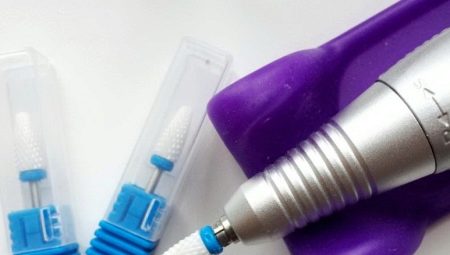
One of those tools, the presence of which makes it possible to significantly facilitate the work of manicure masters, are cutters - special nozzles created to solve a variety of tasks. The latter also includes the removal of gel polish - a procedure that is performed using many types of this equipment, differing in material, shape and other characteristics. Special attention should be paid to the peculiarities of working with such cutters, the knowledge of which helps the master to avoid mistakes and achieve the desired result with the least amount of time.

What it is?
Today there are two main ways to remove gel polish. The first involves the use of special fluids called removers, and the second involves the use of a manicure device - a milling cutter. Practice shows that both methods have a mass of convinced supporters, however, experts consider the latter to be much more progressive. This is due to the fact that gel polish removers make nails too dry, gradually weaken them and often provoke delamination of the plates, while cutters do not lead to such problems.
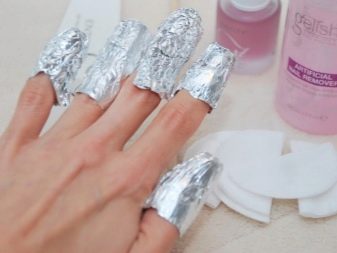
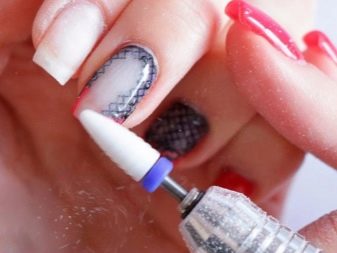
Important: the main reason for brittle nails is not gel varnishes, as many still believe, but removers, which include aggressive chemical compounds.
Given this circumstance, craftsmen increasingly prefer cutting coatings using milling cutters - rotating tools equipped with durable tips.To solve this problem, they use the same device that is designed to perform hardware manicure, changing the attachments to more suitable ones. Removing gel polish in this way involves processing the surface of the nail with a cutter, which has a very high rotation speed.
If the device is in the hands of an experienced technician, the hardware cutting does not last long. - on average from 5 to 15 minutes - and does not cause any unpleasant sensations for the client. Provided it is performed correctly by the master, this procedure does not lead to damage to the nail (due to the fact that the rotating parts do not come into contact with its natural surface). Moreover, the preservation of the base coat only strengthens the plate, increasing its resistance to negative external influences.
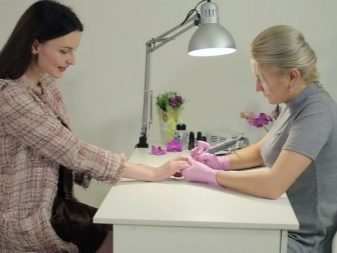

As for the disadvantages of the method for removing gel polish using cutters, they are listed below:
- inadmissibility of processing nail plates, characterized by severe dystrophy and increased sensitivity;
- the high cost of a router and nozzles that meet international quality standards (low-quality products are cheaper, but their performance and durability leave much to be desired);
- inability to use in situations with customers suffering from dust allergies.
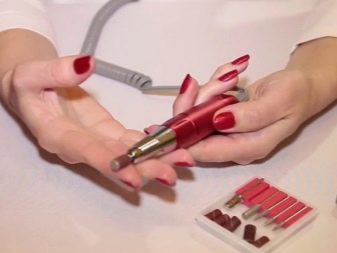

Also, experts do not advise removing the gel polish with a low-power router, in order to avoid overheating of the nail plate.
Varieties
Despite the many types of attachments that are successfully used by masters of hardware manicure, only two of their varieties are most often used to remove gel polish - metal and ceramic. The reason for this is the properties of the materials from which such cutters are made, which allow solving the assigned tasks with maximum efficiency.
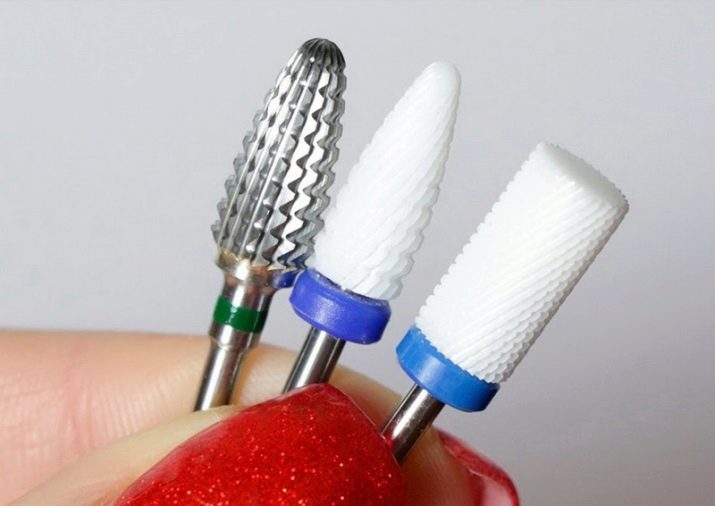
Metal
The materials used in this type of packing are hard alloys, which are relatively inexpensive and have a decent service life. Other features of these cutters are the following characteristics.
- Various notch shapes. They can be straight, oblique or made in the form of a cross.
- Shearing off material with the formation of chips. The use of carbide tips does not generate dust.
- Rotation capability: both clockwise and bi-directional. The first type of nozzles is called conventional, and the second is reversible.


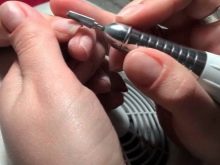
Another feature of metal cutters for removing gel polish that professionals pay attention to is the size of the notches. It is desirable that the latter are large - in order to avoid getting the removed material into the grooves between the teeth and clogging the nozzle.
Ceramic
The described type of cutters appeared relatively recently, but already now it can boast of impressive popularity. These attachments are made from ceramics containing plastic clays, bone ash, feldspar and other ingredients to produce a material with optimum strength and wear resistance.
Ceramic cutters have the following key features:
- impressive hardness, which allows it to last 3-4 times longer than the best carbide tips;
- soft action, thanks to which the master can perform work that requires special precision and delicacy;
- minimal heating upon contact with the treated surface, which avoids the appearance of unpleasant sensations for the client;
- no problems caused by clogging (the coating removed by the ceramic cutter turns into dust, not chips).
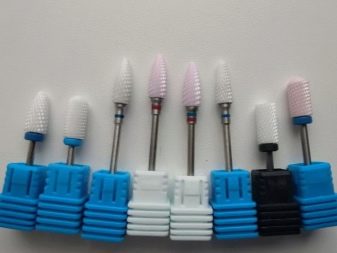
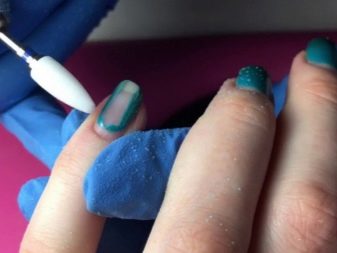
The latter circumstance can be considered both an advantage and a disadvantage of the described variety of nozzles - due to the fact that a large amount of varnish dust is in the air and scatters around the room. To avoid this trouble, you can use a special vacuum cleaner, which is part of the manicure apparatus or installed separately.
How to choose a router bit?
The first thing to look for when buying a gel polish remover is the reputation of its manufacturer. This means that the purchase of products of dubious origin that do not have a certificate should be abandoned in order not to risk the health of the client and the performance of the equipment used. Another important criterion to consider when choosing a cutter is the shape of the head. Its main varieties are:
- cylindrical (can be straight or rounded);
- needle-shaped;
- equipped with a small ball at the end;
- cone-shaped (classic or truncated);
- curly (can be in the form of a lance or a bullet).

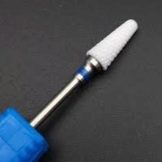

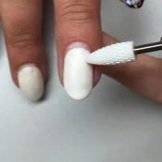
Most often, manicurists use a ceramic nozzle similar in shape to a truncated cone, which is called "corn". This popularity is due to the high efficiency and safety of using this tool.
Special attention should be paid to the rules for choosing a cutter in accordance with the tasks being performed:
- in order to remove gel polish from a surface with a large area, it is most rational to use a nozzle in the shape of a cylinder;
- for tidying up the places that are most difficult to get to, a milling cutter with a pointed tip is suitable;
- if you need to get rid of the thick layer of gel polish located under the growing edge of the nail plate, you should use a needle-shaped or lance-shaped tool.
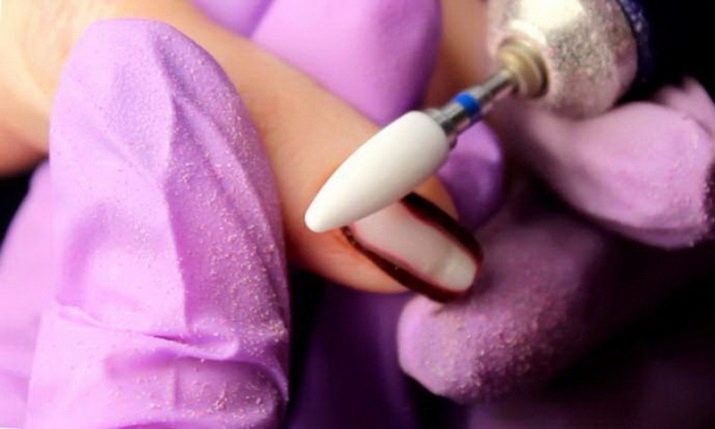
Equally important is the correct selection of cutter rigidity. So, for working with artificial nails, it is necessary to give preference to harder nozzles, and vice versa with natural nails. A special "belt" - marking, which is applied to the shank of the product, will help to find a tool with a stiffness suitable for the master. The milling cutters marked in yellow have the least hardness, then (in ascending order) are the red, blue and green tips, and the hardest are the tools with black marks. Depending on the manufacturer, the tones used may vary, but the principle remains the same: the darker the marking, the harder the bit.
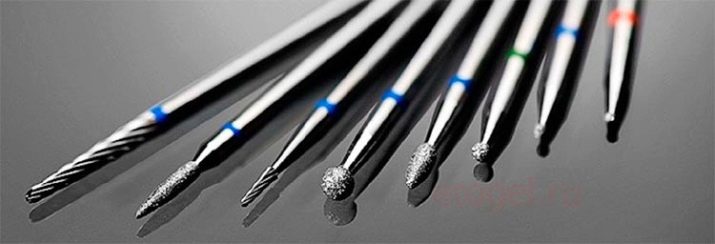
Also, experts advise getting several cutters for removing gel polish, which differ not only in shape, but also in rigidity. Having 4-5 different attachments, the master can improve the quality of the work performed and significantly reduce their duration. If the owner of the device plans to carry out procedures at home, at first he should make a choice in favor of a ceramic instrument. Such products are optimally suited for natural nails and are better perceived by sensitive skin.

Recommendations for use
In order to avoid damage to nails during the hardware removal of gel polish, the master must follow some of the rules for carrying out this procedure.
- When removing the cover from the plate, pay special attention to the elbow. It should be located as steadily as possible, so as not to remove excess from the surface of the nail due to accidental slipping.
- You need to get rid of the gel polish carefully, making smooth stroking movements, lightly touching the nail with the working tool, and then moving away from it. In a similar way, dentists treat teeth, cleaning them from damaged tissues. Following this recommendation, you can negate the likelihood of overheating of the nail plate and the appearance of unpleasant sensations for the client.

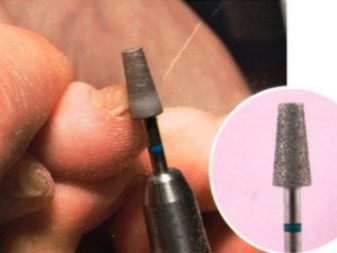
- It is better to start removing the coating from the middle of the nail. In such cases, long and unhurried movements are appropriate, and for processing the outer edge of the plate, they should be sawing.
- The router must not be held vertically, but slightly tilted (for safety reasons). For the same reason, professionals advise to work not with the tip of the nozzle, but with its middle part.
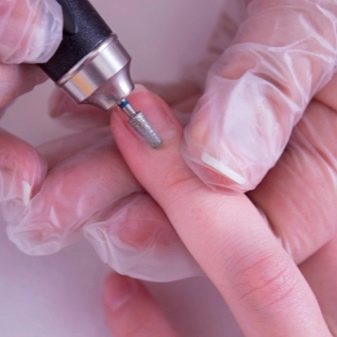
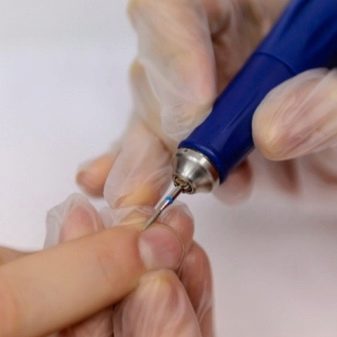
- Movements need to be done only in the direction of rotation of the cutter.Ignoring this recommendation can lead to slipping of the working tool - a nuisance that does not bode well.
- Nozzles designed for hardware manicure should not be used to remove gel polish (and vice versa). Each type of work involves the use of appropriate tools.
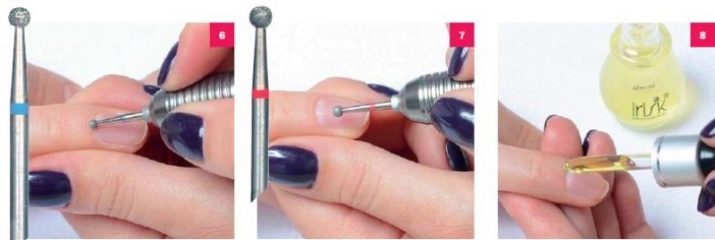
- If the coating to be removed provides for the presence of rhinestones, it is most rational to cut them with a diamond cutter.
- When removing gel polish using ceramic attachments, it is advisable for the master to use a mask. In this way, the lungs can be effectively protected from dust. In addition, many experts consider wearing an apron compulsory.
- At the end of the removal of the outer layer, when the base is already clearly visible, it is necessary to replace the cutter with a polishing one (an alternative solution is a buff) and perform the final alignment of the nail.
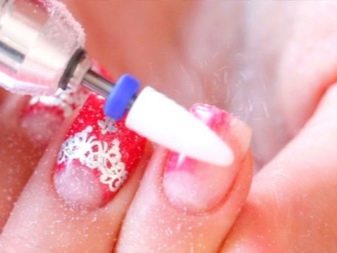

It is also worth mentioning the rotation speed of the nozzle: it should be 10-15 thousand revolutions per minute for ceramic cutters and at least 20 thousand for carbide tips. The optimal value recommended by professionals is much higher - from 30 to 40 thousand rpm. Using a tool rotating at such a speed allows you to reduce the heating of the nail plates to a minimum value. This circumstance must be taken into account in advance when purchasing a universal device for manicure or pedicure.
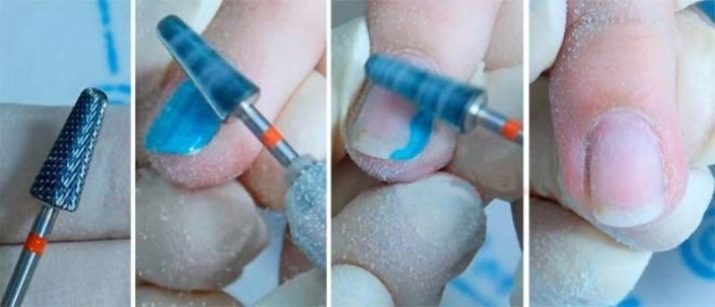
For complete disinfection of the nozzles, it is best to use an ultrasonic cleaner or dry oven. As for UV sterilizers, they only partially cope with this task, and therefore cannot be considered the optimal solution.
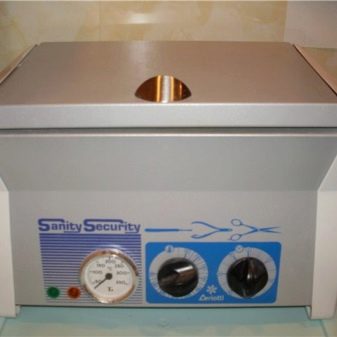
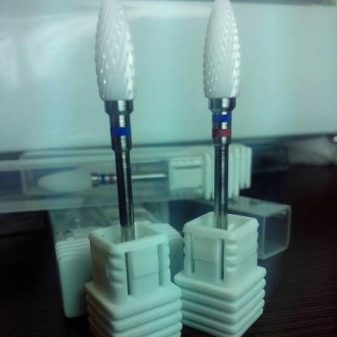
Separate consideration deserves the purchase of tools designed for hardware removal of gel polish or other procedures at home. Often, girls take such a step for the sake of saving, since many craftsmen charge a separate fee for removing the old coating. Experts consider such acquisitions to be very rational, but they advise not to forget about the constant improvement of skills and compliance with safety rules when working with the device.
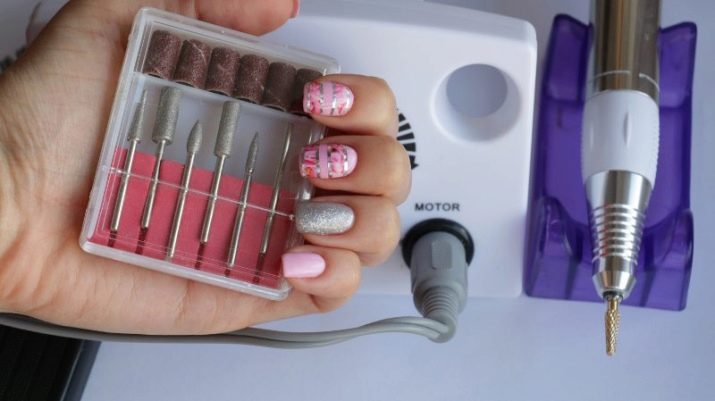
Common myths
One of the main misconceptions that prevent the use of cutters for removing gel polish is the fear of sawing off the nail. To be convinced of the inconsistency of this myth, it is enough to familiarize yourself with some of the arguments.
- Using the device, you can slightly damage the nail, leaving a barely noticeable groove on its surface (but only theoretically, because even for this you will have to try hard).
- Under the outer colored layer of gel polish, there is a base - a kind of reference point for the master. The scheme of actions of the latter when removing the coating does not provide for the removal of the base layer. Hardware, in principle, does not come into contact with a natural nail, and therefore cannot harm it.
- Using a buff to work with the base, you can remove 1-2 keratin layers. Considering that their number in the nail plate exceeds a hundred, such a loss cannot be called fundamental.
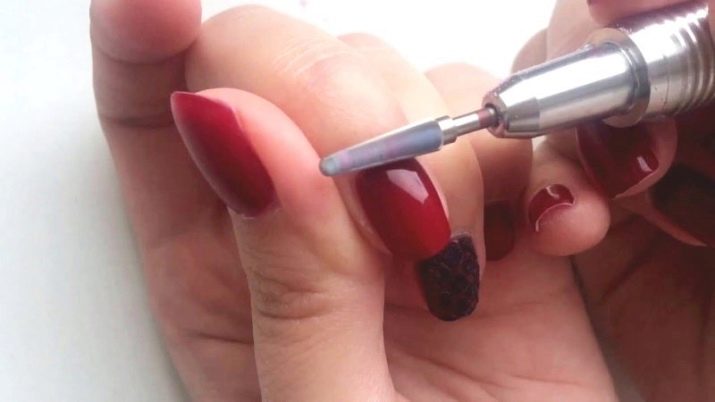
Thus, the cutter does not cut nails - due to the fact that this is not included in the list of her "duties".
The second common misconception is the opinion about the pain that accompanies the hardware removal of gel polish. As a rule, this point of view is shared by women who once entrusted their nails to performers with a low level of skill. If the master has the necessary competence, his actions will never cause pain in the client.
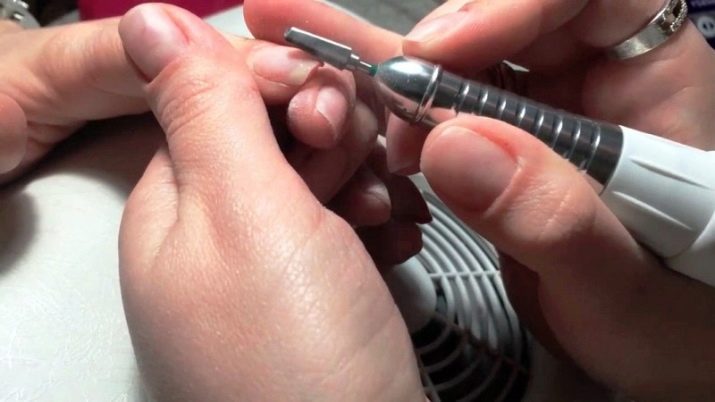
Reviews
After reading the many opinions on removing gel polish with a cutter that are present on the Internet, we can state that for the most part they are very positive. Most often, the fair sex notes the following advantages of this technique:
- significant time savings (in comparison with dissolving gel polish with special liquids);
- no damage to the nail plates and skin, regardless of the frequency of the described procedure;
- many varieties of nozzles for removing gel polish, among which you can always find a suitable option for the client;
- noticeable strengthening of the nail plate, thanks to which it looks healthier and more aesthetic.
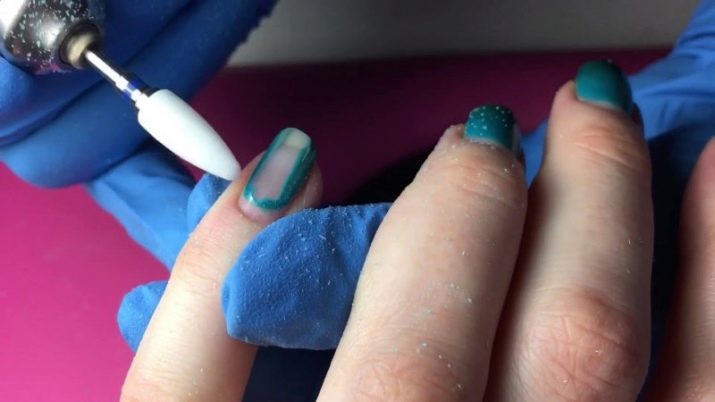
The latter point is explained by the gradual accumulation of the base layer, which increases the thickness of the nails and gives them the correct shape.
In addition, the considered method is preferred by the overwhelming majority of specialists. According to many of them, the right cutter and skillful hands can achieve optimal results in almost any situation.
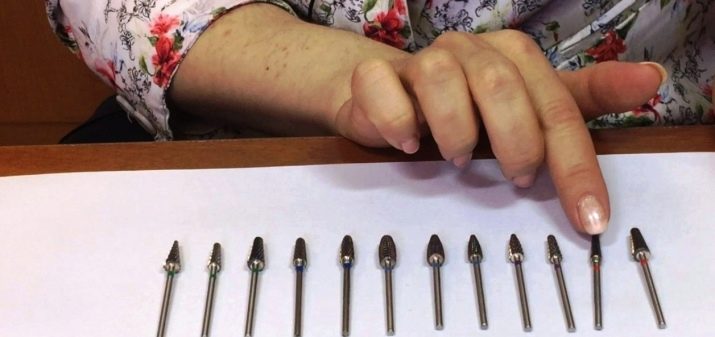
As for negative reviews, most often they mention the discomfort experienced by some women during the hardware removal of gel polish. Its main manifestations are vibration and burning, which often lead to refusal to carry out the described procedure. Typically, this inconvenience is caused by a metal cutter that rotates at a low speed. To solve this problem, it is enough to replace the used nozzle with a ceramic one, which has a lower tendency to heat.

Summing up, we can confidently say that the use of nozzles for removing gel polish is a solution that has a lot of obvious advantages with a minimum number of disadvantages. An experienced craftsman, the availability of the necessary tools and the absence of contraindications - that's all that is required to successfully solve this problem. The validity of this thesis is regularly confirmed in practice - both in specialized salons and in more modest home conditions.
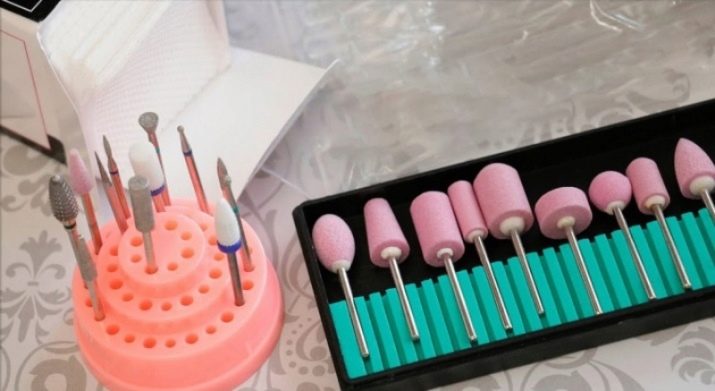
For information on how to choose cutters for removing gel polish, see the next video.








